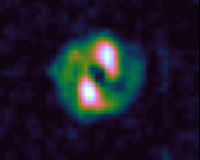Simulating ASKAP Skies Takes Strides

11 November 2011
A supercomputer at the new iVEC Pawsey Centre in Perth has been used for the first time by CSIRO's ASKAP Computing team to simulate how data collected with ASKAP will be processed to create images of the 'radio sky'. These ASKAP 'science simulations' are an important step in planning for the science to be conducted with the new telescope.
Over the past two years, CSIRO's ASKAP Computing team has been working closely with members of the ten ASKAP Survey Science Projects that will be the first science teams to use ASKAP.
In October 2011, the latest round of science simulations were released to the science teams so that they can hone their source-finding algorithms before ASKAP becomes operational in 2013.
The latest simulations were conducted with the iVEC Pawsey Centre's 'epic' supercomputer, which generated more than 1.5 terabytes of data.
The images and cubes produced cover approximately 10 square degrees of sky (a reduced field-of-view compared with the 30 square degrees that will be possible with ASKAP) and up to 4096 channels (a quarter of ASKAP's number).
Two distinct simulations were done:
- One was a simulation of the extragalactic sky, made up of two distinct components. The first contained compact continuum sources taken from the SKA Design Studies (SKADS) Simulated Skies, with polarisation information added by Jeroen Stil (University of Calgary/POSSUM). The second contained neutral-hydrogen emission from a large number of galaxies, provided by WALLABY and DINGO team members at the University of Western Australia. Real observations of galaxies were taken and shifted to locations given by a cosmological simulation, providing a realistic looking model sky.
- The other set used an enhanced version of the Milky Way hydrogen-line cube provided by the GASKAP team that was used during earlier simulations conducted in 2010. This takes real data from the Galactic All-Sky Survey (McClure-Griffiths, CSIRO et al.) and combines it with SKADS continuum sources, as well as absorption-lines from the Galactic hydrogen.
The ASKAP Survey Science Projects will use the simulations to test analysis techniques such as source finding and measurement of source parameters, and to examine the quality of the imaging for different types of sources. This will enable them to provide feedback to CSIRO's ASKAP Computing team to improve the processing pipeline and, ultimately, the science that will be done with ASKAP.
Once operational, data generated by ASKAP will be turned into usable science products with the peta-scale computing system at the new iVEC Pawsey Centre.
Back to Latest ASKAP News page.
